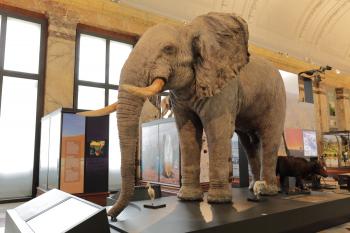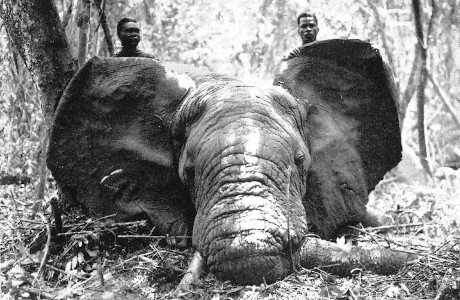Elephant
17.08.2021
- Inv. n° 25421
- Killed in Kasaï on 4 August 1956 by Chevalier de Wouters during a museum expedition led by Max Poll.
- Prepared in London by taxidermy firm Rowland Ward Ltd., founded by James Rowland Ward (1848-1912, uncle of sculptor Herbert Ward), between 1956 and the end of 1957.
- Exhibited in the 'Congo Fauna Pavilion' at the Brussels World's Fair, March-October 1958.
- Arrived at the museum at the end of 1958.

Displayed in the museum's introductory display, across from the sculpture depot, Chéri Samba’s painting Réorganisation portrays a tug-of-war between a group of Belgians and a group of Congolese over the so-called ‘leopard man’ sculpture. Seemingly watching on in the background, the museum's stuffed elephant is in fact the first 'problematic' exhibit to have been removed from the building. Although depicted on a small base like a sculpture, its distinctive profile stands against a backdrop of greenery, as if somewhat restored to its natural environment and vitality.
While it is important to challenge the historical processes and social practices that led to its geographical relocation from Congo to Belgium (as with the museum's cultural objects), in this instance it is also the creature’s transition from life to death and its transformation into an exhibit that we need to question.
Indeed, this bush elephant (Loxodonta africana) has long been an emblem of the Royal Museum for Central Africa and far from being relegated to the background as suggested in Samba's painting, it still holds a prime place in the Landscapes and Biodiversity Room.
Context
African elephant populations were drastically reduced with the mass introduction of firearms on the continent. Victims of the large-scale ivory trade and excessive international demand in this sector (now heavily regulated - see the CITES display in the same room) from the mid-19th century, these animals have also suffered from the disappearance of their natural habitat which began in the 20th century.
As such, the elephant could be viewed as an important 'symbol' of wildlife that is directly and indirectly endangered by humankind. Indeed, this animal's presence in the museum no longer inspires instant wonder among today’s generations of visitors.
This sense of the spectacular, of 'wonder', however, was exactly what the museum's director sought when he devised the project to display such a specimen in the mid 1950s:
Feu Frans M. Olbrechts, ancien et regretté directeur de notre Musée, si attentif à ce qui pouvait embellir son Institution, me demanda d’organiser l’expédition nécessaire pour récolter et préparer les animaux et tous les objets qui pourraient éventuellement servir à la reconstitution des différents milieux.
"The late Frans M. Olbrechts, former director of our Museum, so aware of what may enhance his Institution, asked me to organise the expedition necessary to collect and prepare the animals and all the objects that could potentially be used to recreate the various habitats." (Poll (1) 1958: 35)
With scientific research exceptionally taking a back seat to curation, the historical context of the zoological expedition entrusted to Max Poll in 1956 is highly unusual for the institution. Aiming to collect samples of fauna that were representative of the four main ecosystems of the Congo, the expedition's primary objective was to create dioramas for the public.
Un certain nombre de ces animaux parmi les plus spectaculaires seront exposés au pavillon de la Faune de la section du Congo Belge de l’Exposition internationale de Bruxelles en 1958.
"A number of the most spectacular animals will be exhibited in the Belgian Congo section’s Fauna Pavilion at the Brussels World's Fair in 1958." (Poll (2) 1956: 445)
As the perfect answer to this desire for visual impact, the elephant would naturally be part of the display in the Congolese Fauna Pavilion at the Brussels World's Fair in 1958.
When the World's Fair closed on 19 October 1958, the animals were transferred to the Royal Museum of the Belgian Congo.
The museum's zoological expedition
In July 1956, the museum undertook a major zoological expedition in Ituri and Kasaï, under the leadership of ichthyologist (fish specialist) Max Poll. He was accompanied by two of the museum's staff, Armand Opdenbosch (1929–1977), chief technician and taxidermist, and his young colleague, Louis Poelman.
Using air travel, the Poll expedition managed to rapidly collect a large number of specimens representative of the different ecosystems of the Congo (elephant, okapi, chimpanzee, hippopotamus, giraffe, leopard, etc.):
Ils rassemblèrent au total 343 peaux, 357 crânes et 52 squelettes complets
"In total, they collected 343 skins, 357 skulls and 52 complete skeletons" (Couttenier 2010: 95-97)
Prior organisation from Belgium requesting local assistance, also helped save time. The elephant, for instance, was identified and tracked for more than two weeks before the museum team arrived.
Two Congolese guards, working in the Luisa hunting reserve under Commandant A.J. Jobaert, were tasked with tracking the elephant.
Less than one week after the museum team arrived in Congo, they caught up with the animal near Mbuji-Mayi River (southern Kasaï) as it sheltered in the forest for the day. This is where it was shot and killed by Chevalier de Wouters, a hunter who had joined the expedition specifically for this purpose.
The elephant fell in an inextricable position against a large tree and it was necessary to call on some hundred villagers from the surrounding area to move it. Ropes were used to turn it over:

When the animal had been butchered, the meat was distributed.
It then took several days to prepare the skin, skull and rest of the bones. Once again, the expedition's members were assisted by Congolese people under the supervision of the museum's technicians. Looking back, Poll was pleased with this organisation:
Cette expérience, justifiée par les nécessités de la préparation des peaux, fut couronnée de succès. Non seulement les préparations furent impeccables mais partout où nous séjournâmes les noirs apprirent facilement les méthodes rationnelles de taxidermie.
"This experience, justified by the necessities of preparing the skin, was a great success. Not only were the preparations impeccable, but wherever we stayed, the blacks easily learnt the rational methods of taxidermy." (Poll 1958: 35)
By highlighting the transmission of skills from Belgian professionals to the 'passive', assisting Congolese population, Poll overlooks the existence of local know-how.
He demonstrates an attitude of superiority that was common in the colonial period, in which the Congolese people were entrusted to carry out essential tasks, but were always subordinate.
Not only that, but hunting was an area that was particularly conducive to stratification (not just 'racial' either) of the various players present. Photographs of the expedition testify to the glorification of Western hunting figures and/or their flawless mastery of its codes.
The codification of the hunt gradually came to prevail in the colony along with the increasingly strict regulations that governed it.
In this context, 'indigenous' hunters were often relegated to the status of poachers.
Exemptions, with hunting quotas in the reserves and parks, generally applied to the benefit of Westerners.
Nevertheless, while the museum was able to receive all the authorisations needed and the active support of the colonial government to achieve its objective, this would not necessarily have been the same for a 'foreign' (non-Belgian) scientific institution, due to tensions and persistently strong international competition between Western powers over Africa's natural resources, including its wildlife.
As shown by the depiction of Congo at the Belgium World’s Fair 1958, two years before independence, the wild fauna continued to represent, for Belgium, a prestigious symbol of its colony’s wealth to be shown off to the world.
Another animal from Max Poll's expedition
The giraffe on display in the same room of the museum as the elephant was also collected during the 1956 Poll expedition and was likewise presented at the Brussels World's Fair in 1958.
Very few specimens in the museum's collections were hunted specially to be displayed, apart from representatives of certain 'key species'.
But in certain cases, the imperious desire of Western institutions to acquire specimens for display may have had tragic consequences for the species concerned, as with, at the start of the 20th century, the race for the 'museum trophy' of mountain gorillas (eastern Congo).
Text compiled from a draft by Agnès Lacaille based on specific research and a synthesis of the data below.
SOURCES
Interviews: Christine Bluard, Garin Cael, Annick Debaillie, Sophie De Ville, Tine Huyse, Claire Poinas, Patricia Van Schuylenbergh, Anne Welschen, the museum's team of tour guides.
Archives:
- Zoology section: 'Rowland Ward' record, M. Poll records.
- Museum Studies section: records of the film of the restoration of the elephant and press review
Bibliography:
- "De renovatie van een olifant", Onze Tijd, February 2001, no. 157, pp. 30-31
- "De Savanneolifant" (article without reference, press review from the archive record, Museum Studies section)
- Sabine Cornelis "Le colonisateur satisfait ou le Congo représenté en Belgique (1897-1958)", La mémoire du Congo, le Temps colonial, MRAC 2005, pp. 159-169.
- Maarten Couttenier, Si les murs pouvaient parler, Tervuren, MRAC, 2010, 158 p.
- Max Poll (1), "Une mission zoologique taxidermique du musée royal du Congo Belge (1956)", Congo-Tervuren, 1959, V- 2, pp. 35-40
- Max Poll (2), "Note sur l’éléphant géant du Kasaï dépouillé au Congo en 1956 par la Section des Vertébrés du Musée Royal du Congo", Bull. Eaux et Forêts du Congo belge (Léopoldville), 6 (22), 1958, pp. 445-449.
- Patricia Van Schuylenbergh, De l’appropriation à la conservation de la faune sauvage. Pratiques d’une colonisation : le cas du Congo belge (1885-1960), doctoral thesis, Louvain-la-Neuve, 2006, 947 p.
The information contained in this article is mostly based on resources available at the museum (archives, publications, etc.). The specimen's biography, therefore, can still be developed further. Do you have any comments, information or stories to share? Please contact us: provenance@africamuseum.be.
In the framework of the Taking Care project.

